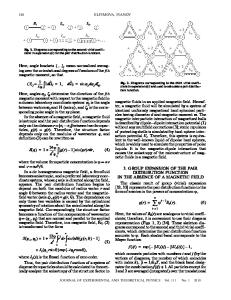On the theory of phase transitions in magnetic fluids
- PDF / 324,038 Bytes
- 17 Pages / 612 x 792 pts (letter) Page_size
- 44 Downloads / 364 Views
SORDER, AND PHASE TRANSITION IN CONDENSED SYSTEMS
On the Theory of Phase Transitions in Magnetic Fluids A. Yu. Zubarev and L. Yu. Iskakova Department of Mathematical Physics, Ural State University, pr. Lenina 51, Yekaterinburg, 620083 Russia e-mail: [email protected] Received May 31, 2007
Abstract—Particles of magnetic fluids (ferrofluids), as is known from experiments, can condense to bulk dense phases at low temperatures (that are close to room temperature) in response to an external magnetic field. It is also known that a uniform external magnetic field increases the threshold temperature of the observed condensation, thus stimulating the condensation process. Within the framework of early theories, this phenomenon is interpreted as a classical gas–liquid phase transition in a system of individual particles involved in a dipole– dipole interaction. However, subsequent investigations have revealed that, before the onset of a bulk phase transition, particles can combine to form a chain cluster or, possibly, a topologically more complex heterogeneous cluster. In an infinitely strong magnetic field, the formation of chains apparently suppresses the onset of a gas– liquid phase transition and the condensation of magnetic particles most likely proceeds according to the scenario of a gas–solid phase transition with a wide gap between spinodal branches. This paper reports on the results of investigations into the specific features of the condensation of particles in the absence of an external magnetic field. An analysis demonstrates that, despite the formation of chains, the condensation of particles in this case can proceed according to the scenario of a gas–liquid phase transition with a critical point in the continuous binodal. Consequently, a uniform magnetic field not only can stimulate the condensation phase transition in a system of magnetic particles but also can be responsible for a qualitative change in the scenario of the phase transition. This inference raises the problem regarding a threshold magnetic field in which there occurs a change in the scenario of the phase transition. PACS numbers: 75.50.Mm, 64.70.Nd, 82.70.Dd DOI: 10.1134/S1063776107110143
1. INTRODUCTION Magnetic fluids (ferrofluids) are colloidal suspensions of subdomain magnetic particles in a carrier liquid medium. The characteristic size of particles in ferrofluids varies in the range from 10 to 20 nm. In order to prevent coagulation of particles subjected to van der Waals dispersion forces, they are coated with special layers of surfactant molecules (other types of coatings are also known) that partially or completely screen the dispersion forces. The considerable interest expressed by researchers and engineers in magnetic fluids is explained by a unique combination of their hydrodynamic fluidity (which is typical of conventional liquids) and a high magnetization comparable to the magnetization of solid magnets. In an external magnetic field, ferrofluids can be set into a macroscopic motion and their free surfaces can be shaped to vari
Data Loading...











